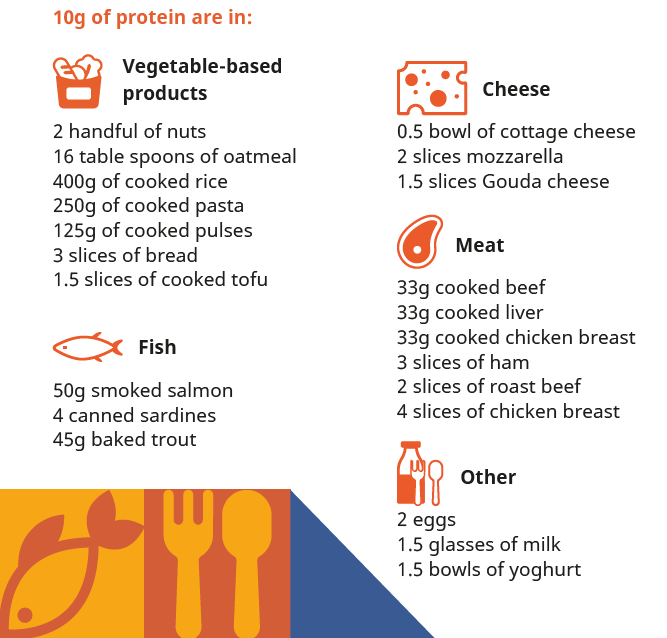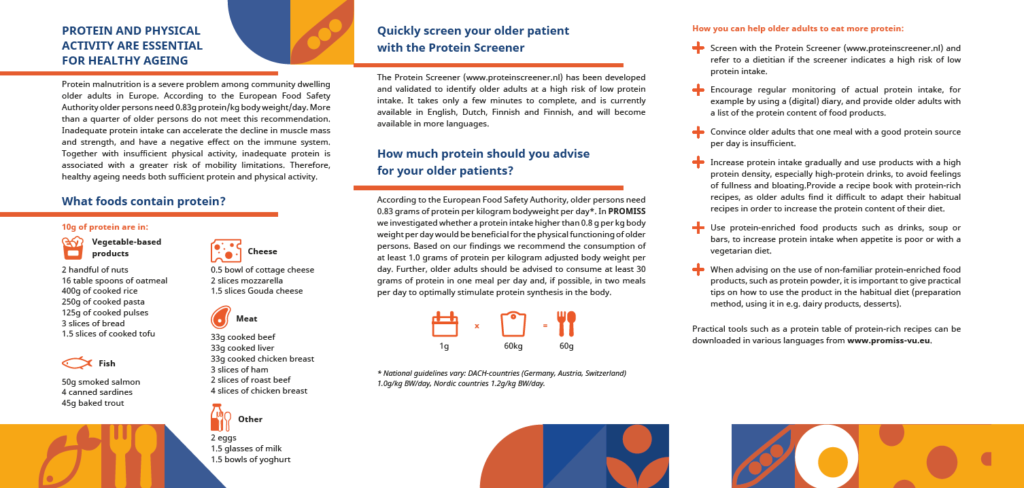Health professionals
Download the brochure for health care professionals as .pdf (click here)
The PROMISS recommendations for health care professionals are also available in German (click here).
PROTEIN AND PHYSICAL ACTIVITY ARE ESSENTIAL FOR HEALTHY AGEING
Protein malnutrition is a severe problem among community dwelling older adults in Europe. According to the European Food Safety Authority older persons need 0.83g protein/kg body weight/day. More than a quarter of older persons do not meet this recommendation. Inadequate protein intake can accelerate the decline in muscle mass and strength, and have a negative effect on the immune system. Together with insufficient physical activity, inadequate protein is associated with a greater risk of mobility limitations. Therefore, healthy ageing needs both sufficient protein and physical activity.
What foods contain protein?

Quickly screen your older patient with the Protein Screener
The Protein Screener (www.proteinscreener.nl) has been developed and validated to identify older adults at a high risk of low protein intake. It takes only a few minutes to complete, and is currently available in English, Dutch, Finnish and Finnish, and will become available in more languages.
How much protein should you advise for your older patients?

According to the European Food Safety Authority, older persons need 0.83 grams of protein per kilogram bodyweight per day*. In PROMISS we investigated whether a protein intake higher than 0.8 g per kg body weight per day would be beneficial for the physical functioning of older persons. Based on our findings we recommend the consumption of at least 1.0 grams of protein per kilogram adjusted body weight per day. Further, older adults should be advised to consume at least 30 grams of protein in one meal per day and, if possible, in two meals per day to optimally stimulate protein synthesis in the body.
How you can help older adults to eat more protein:
- Screen with the Protein Screener (www.proteinscreener.nl) and refer to a dietitian if the screener indicates a high risk of low protein intake.
- Encourage regular monitoring of actual protein intake, for example by using a (digital) diary, and provide older adults with a list of the protein content of food products.
- Convince older adults that one meal with a good protein source per day is insufficient.
- Increase protein intake gradually and use products with a high protein density, especially high-protein drinks, to avoid feelings of fullness and bloating.
- Provide a recipe book with protein-rich recipes, as older adults find it difficult to adapt their habitual recipes in order to increase the protein content of their diet.
- Use protein-enriched food products such as drinks, soup or bars, to increase protein intake when appetite is poor or with a vegetarian diet.
- When advising on the use of non-familiar protein-enriched food products, such as protein powder, it is important to give practical tips on how to use the product in the habitual diet (preparation method, using it in e.g. dairy products, desserts).
Practical tools such as a protein table of protein-rich recipes can be downloaded in various languages from the PROMISS website.
Sustainable protein
Vegetable proteins are more sustainable than animal proteins, yet both result in similar clinical outcomes in older persons. In providing protein advice, it is important to realize that older adults may find:
- animal-based protein sources (e.g. poultry, fish or beef) more appealing than more sustainable protein sources (e.g. plant-based meat substitutes);
- fish consumption acceptable and liked. Fish fits in a sustainable diet (though no more frequent than once a week);
- going completely vegan or vegetarian unacceptable;
- that health, sustainability, familiarity and knowledge about environmental impact, all play a role in the consumption of protein-enriched products.
How you can help older adults to eat protein in a more sustainable way:
- Encourage eating more plant-based protein such as legumes and pulses, whole grains, nuts and seeds and soy products.
- Assure older adults that there is no need to go completely vegan or vegetarian.
- Advise reducing intake of beef, lamb, and processed meats (such as cooked ham, pate or salami).
- Emphasize choosing chicken or pork if meat is eaten.
- Fish is a good protein source, but advise not to eat fish more than once a week, and encourage choosing certified sustainable fish.
More exercise is more quality of life
While higher physical activity is associated with health benefits, and staying mobile and independent in older age, the majority of older adults are inactive and have a sedentary life style.
Being physically active has a positive impact on brain health and helps to prevent frailty. Older adults should therefore be encouraged to be more physically active and reduce the time they spend sitting. This can contribute to a better quality of life.
How you can help older adults in becoming more physically active:
- Encourage older adults to be as physically active as their functional ability allows. Let them know that any activity is better than no activity!
- Motivate older adults to interrupt their sitting time as much as possible.
- Encourage moderate activity (= breathing harder and sweating lightly) for at least 150 minutes per week, e.g. walking for 30 minutes 5 days a week.
- Recommend functional balance training as a daily routine, and strength training on two or more days a week.
- Help older adults to integrate more physical activity into their daily routine. This could be rising from a chair as often as possible, with a minimum of 5 times a day, and if possible, without using the arms to help.
- Use posters to help people be aware of the need to exercise, and the type of exercises. Examples of such posters can be found in the “Additional resources” below.
Additional resources:
